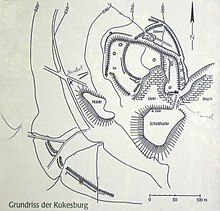Kukesburg
| Kukesburg | ||
|---|---|---|
|
Wall of the castle complex |
||
| Creation time : | 200-1000 | |
| Castle type : | Hilltop castle | |
| Conservation status: | Ditches, walls, remains of walls | |
| Place: | Jump | |
| Geographical location | 52 ° 9 '40.5 " N , 9 ° 31' 45" E | |
| Height: | 260 m above sea level NN | |
|
|
||
The Kukesburg is a former Wallburg on a western spur of the ridge Nesselberg , between the Springer district Altenhagen I and the Coppenbrügger Gemeindeteil Brünnighausen.
The complex was built in different sections, with the oldest construction phase in the 3rd century BC. Is suspected. It was never permanently inhabited, but served the population as a refuge in times of war .
Surname
The name of the Kukesburg, first mentioned in 1007, refers to the term Kukswall , which means border wall. The facility was on the border of the Saxon tribes of Engern and Ostfalen . Later, in medieval times, the border between the dioceses of Minden and Hildesheim ran here . The vernacular called the Kukesburg also Hünenburg as a forecast, according to their burial have lived.
Structure and time of origin
The fortification was built in several construction periods. The ramparts built in the process partially overlap one another. In the earliest prehistoric building phase there was an oval fastening ring, consisting of a wall and a moat. The time of origin is in the time of the 3rd century BC. Assumed.
The younger part of the complex was formed from a wall-earth wall construction. An approximately 2 m high and 1.5 m thick stone wall served as external protection. Inside, a wall of earth was poured in. This enclosed an area of 150 × 100 m. The complex was surrounded by a ditch . The remains of the wall are now largely covered by earth. The builders cleverly included a group of rocks in the fortification. The castle gate was inserted between four large stone blocks. This is evidenced by the machined holes in the rock that took up the wooden structure of the gate. The origin of this area is assumed to be in the 9th and 10th centuries. At that time it was part of a group of similar facilities in the area.
exploration
The Kukesburg has not yet been archaeologically examined. In 1883 it was first measured by Major General a. D. August von Oppermann and described in the "Record of the prehistoric and early historical ramparts in Lower Saxony". In 1888 the defense system was included in the "Atlas of prehistoric fortifications in Lower Saxony", which the archaeologist Carl Schuchhardt later continued.
Sandstone mining
Part of the historic facility was destroyed when the late 19th to early 20th century, a quarry to reduce the Deister - sandstone into eating in the castle area. An underground corridor also dates from this time, which leads under the eastern castle wall and connects the "White Quarry" directly adjacent to the castle area with the mining sites in the castle area.
The light-colored sandstone banks in the area of the Nesselberg are of the highest quality, also because of their thickness of up to 10 m. The stone blocks quarried here were used together with material from Obernkirchen and the Deist stone quarries for buildings such as the New Town Hall , the Opera House and the State Museum in Hanover and the Reichstag building in Berlin .
Similar fortifications in the vicinity
- In the plane:
- Isenburg near Barsinghausen -Landringhausen
- Düsselburg near Rehburg
- Lüningsburg near Neustadt am Rübenberge
- In height:
- Sachsenwall near Nordstemmen
- Heisterburg near Lauenau - Feggendorf
- Wirkesburg near Lauenau-Feggendorf
- Barenburg near Eldagsen
- Heisterschlösschen near Beckedorf
- Bennigser Castle near Bredenbeck- Steinkrug
Fortifications of this kind were originally regarded as Saxon or Heinrichsburgen by archaeological research . The more recent research assigns the structures in the area of the Central Weser and the Leine to a period from the 8th to the 12th century. Due to the lack of settlement, the facilities are likely to have only been used sporadically and have served as refuges. In the case of the facilities in the Deister area (Wirkesburg, Bennigser Burg, Heisterschlösschen) it is typical that they were built on sloping mountain ridges and near a stream.
literature
- Hery A. Lauer : Archaeological walks in southern Lower Saxony. A guide to sights of prehistory and early history. Volume III, Verlag H. Lauer, Angerstein 1988, pages 56 to 58 with references.
- Ernst Andreas Friedrich : The Kukesburg on the Nesselberg , pp. 51–53, in: If stones could talk , Volume II, Landbuch-Verlag, Hanover 1992, ISBN 3-7842-0479-1 .
- Hans-Wilhelm Heine : The prehistoric and early historical castle walls in the district of Hanover , 2000, Hanover, ISBN 3-7752-5645-8 , pp. 114-116.
Web links
- Entry by Hans-Wilhelm Heine and Stefan Eismann zu Kukesburg in the scientific database " EBIDAT " of the European Castle Institute
- Kukesburg in the Lower Saxony Monument Atlas
- Sketch of the location with the wall structure at the support association of the Landesmuseum Hannover



